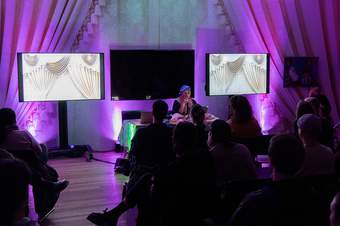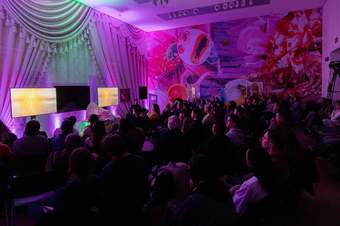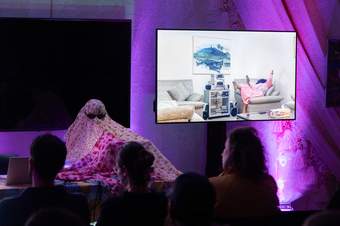Sitting amid the sounds of Farah Al Qasimi’s Mother performance was not only sensorial and all-encompassing, but also took me back to the technology of my 1990s childhood, when ‘noise’ was inescapable and the primary signifier of digital progress. The sound of dial-up internet and the ‘turning on’ of the machine were all part of an orchestra of synthesised hums and blaring noises that I seldom miss. But they were signs that we were embarking on a cultural shift in the ways that information would be recorded, disseminated and received.
Al Qasimi is an artist from the United Arab Emirates, based in Brooklyn, New York. Mother was a lecture-performance set in her photographic display at Tate Modern, with both performance and display touching on themes of spirituality and culture-specific motifs, particularly relating to West Asia. Engulfing the room was an overlap of visual data across the walls: images of fruit, textiles and flowers lay beneath framed images of Al Qasimi’s most notable photographic works, creating an immersive experience for the audience.
After an introduction by Nabila Abdel Nabi, Senior Curator of International Art at Tate, Al Qasimi covers herself in a textile that perfectly matches the domestic wallpaper within the space, a significant act in her performance as the narrator of the story. The textile cover is a tool to anonymise the narrative, disconnecting Al Qasimi’s identity from the content, and thus encouraging viewers to interpret in the same manner. Behind the covered figure, a film begins to play, featuring a distressed voice coating the space, followed by moments of disturbance captured through what sounds like a smartphone.

Farah Al Qasimi, lecture performance Mother at Tate Modern, 21 November 2023.
Photo © Tate (Josh Croll).
In both the digital and public realms, there are ghosts in the room: those who are the subject(s) of the videos, and the one who sits shrouded in the chair before the audience, evoking the haunting relationship of what we see and what is ‘true’. Our general acknowledgement of ‘ghosts’ is that they are figments of our imagination, fictitious representations of the after-life; yet there is no certainty that this is true, if what we see before us challenges this.
Al Qasimi’s manipulation of horror tactics through background music and shifting tones of voice creates an air of speculation and thrill as personal and historical footage appears and disappears on-screen, like the continuous scroll of social media apps. Suddenly, the air shifts as a karaoke rendition of Elvis Presley’s Can’t Help Falling in Love breaks the atypical atmosphere. The ghostly figure wears a pair of sunglasses and makes punctuating hand gestures towards the audience. The tone of voice, too, gravitates to a higher pitch as the song progresses; a stark contrast to the notions of ghostliness. This shift in atmosphere is reminiscent of Tiktok and Instagram-style sourcing of information – an overflowing archive of oral history by ordinary people. These platforms have not only redefined what it means to make information and discourse ‘accessible’ but have also created a new ‘familiarity’ with the way history can be digested, which Al Qasimi employs in her media compilation. It is a performance I can experience with my eyes closed or open, as the multi-layered and multi-authored sensorial elements blur, and I am left guessing who is the narrator after all: does the sound come from Al Qasimi or the footage she has gathered?
One of the moments that stood out most to me featured Casper, The Friendly Ghost, a US cartoon that reminds me of my Westernised childhood, and informed my early understanding of the supernatural. In contrast to Jinn – an Arabic term referring to a spirit – ‘Casper’, like many other Western depictions, is seen as the righteous reference: the ‘friendlier’ one. I think about the folkloric stories of spirit-like characters of my own culture in the Caribbean (specifically, Trinidad and Tobago) where we were taught that douens and duppies are evil roamers of uninhabited land, and yet only exist in the chambers of my childhood memory. The Global South, in this aspect, battles to keep these stories alive against the pressure of what is globally recognised as ‘better’.

Farah Al Qasimi, lecture performance Mother at Tate Modern, 21 November 2023.
Photo © Tate (Josh Croll).
These thoughts linger as Al Qasimi reveals herself from beneath the cloth once again, and introduces her film Um Al Naar, which carries the visual of the Jinn at the forefront of the storytelling. Here, the subject of the film holds agency in the telling of their story, and is depicted in a comedic interview-style format. At the same time, the Jinn is humanised through its use of language. ‘Change unsettles me’, says the Jinn, which lightens the air and makes me feel more akin to the Jinn: they are not the friendly ghost, but perhaps something that was once human, that once lived.
Reflecting on Al Qasimi’s performance, I draw connections to my own practice in folkloric histories and orality in the context of global majority cultures. In my experience, they continue to be fragile and resist traditional forms of archiving, which seem kept alive by the metaphorical ‘ghosts’ of the land. For places like my birth country, resources to preserve the spoken word are too expensive and require technological procurements beyond the reach of the average grassroots organisation. So, who tells the stories, and who contains them? These stories, instead, haunt our memories to keep them alive, urging us to share them with the next generation; which feels even more urgent amid the startling realisation that Casper remains the most recognisable ghost to me, even after all these years.
To close the event, Nabila Abdel Nabi joins Al Qasimi for a Q&A, in which the artist unfolds the technical considerations in her practice, and the way some of her decisions come to her as candid as they are methodical. She mentions the ‘privilege’ of living in many places, in order to capture these many textiles and other domestic symbols that resonate with ethnic homes and livelihoods. It is something I often wonder about having the ability to access as a global majority artist. She goes on to expand upon these symbols and furniture in the context of ‘taste’, and how the living rooms of her childhood depicted a different, more ‘gaudy’ aesthetic to that of Western ‘minimalist’ design, associating taste and class with Western-dictated trends, recalling my response to ‘Casper’. I try to hold on to my original thoughts and responses to the performance, alongside absorbing Al Qasimi’s explanations of her performance and practice, which I have come to admire.

Farah Al Qasimi, lecture performance Mother at Tate Modern, 21 November 2023.
Photo © Tate (Josh Croll).
A visit to the display, just days after the performance, feels like stepping into the after-life, as my own mental archive of the performance haunts my interactions with the space, and remains the only existing account of it. Like Al Qasimi’s film and performance pieces, these images on display speak to the ‘archiving’ of stories that are often overlooked, and the deep-rooted connection that (mis)documentation has with global politics. This brings me back to my earlier questions of who tells a story, whose story is told, and who holds onto the story; and, even further, is there an intention behind the ways in which specific stories are misrepresented? Oral histories are tender because they cannot be contained, and therefore the post-colonial archive is an ongoing rebuilding of the moments we record and document today, which Al Qasimi rightfully examines in her performance, film and photography. I leave Tate Modern as I left the performance: reminiscing and holding onto the memory of the stories she shared, so that I can now share them with you; like a duppy, like a Jinn.
Al Qasimi’s performance, film and photography powerfully convey some of the cultural nuances of West Asia, while addressing themes of digital archiving, (mis)representation, folklore and superstition. I felt connected to her work despite our difference in origins. Although her current display is compelling in its own right, Mother, in my opinion, enriched the overall portfolio of work and drew further connections to the cultural and domestic objects in her photographic pieces.
